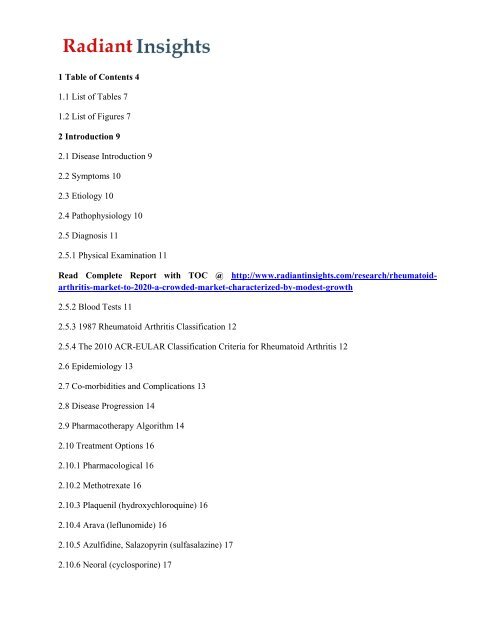Rheumatoid Arthritis Market Share, Size, Growth, Trend & Research Report 2020 Radiant Insights, Inc
Increasingly Crowded Market for Second-Line Therapies Improving Treatment Options for Moderate-to-Severe Rheumatoid Arthritis Patients Rheumatoid Arthritis (RA) is a chronic, progressive and currently incurable autoimmune disease that primarily affects joints. It is characterized by synovial inflammation and gradual bone erosion over many years, and disease progression results in stiffness and pain, especially in the hands and feet, which hinders patient mobility. Without treatment, the disease leads to joint destruction and disability. Prior to 1998, treatment options were limited to small-molecule disease-modifying therapies, such as Methotrexate (MTX), sulfasalazine and anti-malarials. However, while MTX is efficacious in controlling RA symptoms in a large percentage of patients, approximately 33% are unresponsive to these first-line drugs. The approval of revolutionary biological therapies, including Enbrel, Remicade and Humira, for the treatment of RA patients that are refractory to MTX has triggered unparalleled growth in the market. Read Complete Report with TOC @ http://www.radiantinsights.com/research/rheumatoid-arthritis-market-to-2020-a-crowded-market-characterized-by-modest-growth Globally, there are at least 12 biological therapies, including monoclonal antibodies (mAb), biosimilars and therapeutic proteins, competing as second-line therapies for this sub-population. Over the past 16 years, the therapeutic market for RA has become extremely competitive as a result of the high number of new drug approvals. Competition for Tumor Necrosis Factor Alpha (TNF-a) inhibitors is particularly fierce, and now dominates the treatment market for RA patients who are refractory to first-line Disease Modifying Anti-Rheumatic Drugs (DMARD). In 2013, three TNF-a targeting mAbs, Humira (adalimumab), Remicade (infliximab) and Enbrel (etanercept), were ranked among the top-10 best-selling drugs in the world, with global revenues of $11.1 billion, $9.9 billion and $8.9 billion respectively, reflecting their groundbreaking clinical and commercial success. Despite this, 30% of RA patients fail to achieve clinical responses when treated with TNF-a inhibitors (Rubbert-Roth and Finckh, 2009). However, patients who are unresponsive to TNF-a inhibitors can also be medicated with the cytokine modulators Rituxan and Xeljanz. Thus, the extensive range of available therapies is addressing the need for efficacious therapies for a broad spectrum of RA patients.
Increasingly Crowded Market for Second-Line Therapies Improving Treatment Options for Moderate-to-Severe Rheumatoid Arthritis Patients
Rheumatoid Arthritis (RA) is a chronic, progressive and currently incurable autoimmune disease that primarily affects joints. It is characterized by synovial inflammation and gradual bone erosion over many years, and disease progression results in stiffness and pain, especially in the hands and feet, which hinders patient mobility. Without treatment, the disease leads to joint destruction and disability. Prior to 1998, treatment options were limited to small-molecule disease-modifying therapies, such as Methotrexate (MTX), sulfasalazine and anti-malarials. However, while MTX is efficacious in controlling RA symptoms in a large percentage of patients, approximately 33% are unresponsive to these first-line drugs. The approval of revolutionary biological therapies, including Enbrel, Remicade and Humira, for the treatment of RA patients that are refractory to MTX has triggered unparalleled growth in the market.
Read Complete Report with TOC @ http://www.radiantinsights.com/research/rheumatoid-arthritis-market-to-2020-a-crowded-market-characterized-by-modest-growth
Globally, there are at least 12 biological therapies, including monoclonal antibodies (mAb), biosimilars and therapeutic proteins, competing as second-line therapies for this sub-population. Over the past 16 years, the therapeutic market for RA has become extremely competitive as a result of the high number of new drug approvals. Competition for Tumor Necrosis Factor Alpha (TNF-a) inhibitors is particularly fierce, and now dominates the treatment market for RA patients who are refractory to first-line Disease Modifying Anti-Rheumatic Drugs (DMARD). In 2013, three TNF-a targeting mAbs, Humira (adalimumab), Remicade (infliximab) and Enbrel (etanercept), were ranked among the top-10 best-selling drugs in the world, with global revenues of $11.1 billion, $9.9 billion and $8.9 billion respectively, reflecting their groundbreaking clinical and commercial success. Despite this, 30% of RA patients fail to achieve clinical responses when treated with TNF-a inhibitors (Rubbert-Roth and Finckh, 2009). However, patients who are unresponsive to TNF-a inhibitors can also be medicated with the cytokine modulators Rituxan and Xeljanz. Thus, the extensive range of available therapies is addressing the need for efficacious therapies for a broad spectrum of RA patients.
You also want an ePaper? Increase the reach of your titles
YUMPU automatically turns print PDFs into web optimized ePapers that Google loves.
1 Table of Contents 4<br />
1.1 List of Tables 7<br />
1.2 List of Figures 7<br />
2 Introduction 9<br />
2.1 Disease Introduction 9<br />
2.2 Symptoms 10<br />
2.3 Etiology 10<br />
2.4 Pathophysiology 10<br />
2.5 Diagnosis 11<br />
2.5.1 Physical Examination 11<br />
Read Complete <strong>Report</strong> with TOC @ http://www.radiantinsights.com/research/rheumatoidarthritis-market-to-<strong>2020</strong>-a-crowded-market-characterized-by-modest-growth<br />
2.5.2 Blood Tests 11<br />
2.5.3 1987 <strong>Rheumatoid</strong> <strong>Arthritis</strong> Classification 12<br />
2.5.4 The 2010 ACR-EULAR Classification Criteria for <strong>Rheumatoid</strong> <strong>Arthritis</strong> 12<br />
2.6 Epidemiology 13<br />
2.7 Co-morbidities and Complications 13<br />
2.8 Disease Progression 14<br />
2.9 Pharmacotherapy Algorithm 14<br />
2.10 Treatment Options 16<br />
2.10.1 Pharmacological 16<br />
2.10.2 Methotrexate 16<br />
2.10.3 Plaquenil (hydroxychloroquine) 16<br />
2.10.4 Arava (leflunomide) 16<br />
2.10.5 Azulfidine, Salazopyrin (sulfasalazine) 17<br />
2.10.6 Neoral (cyclosporine) 17


















